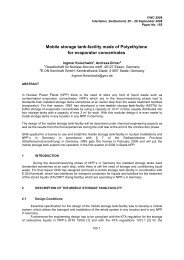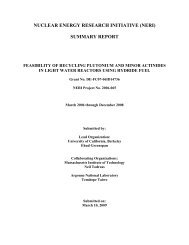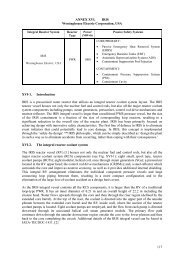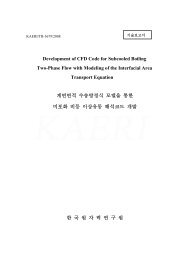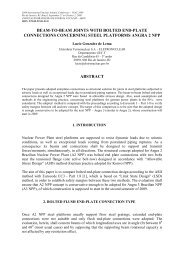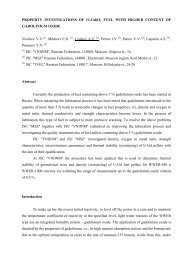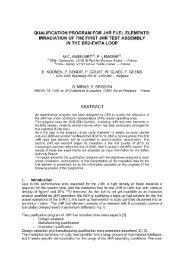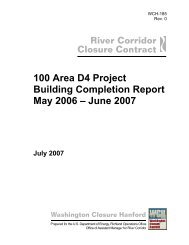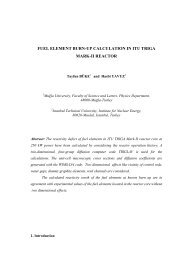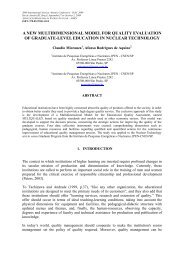Conversion of the WSU reactor to a mixed core of TRIGA- FLIP and ...
Conversion of the WSU reactor to a mixed core of TRIGA- FLIP and ...
Conversion of the WSU reactor to a mixed core of TRIGA- FLIP and ...
Create successful ePaper yourself
Turn your PDF publications into a flip-book with our unique Google optimized e-Paper software.
<strong>of</strong> reactivity, with <strong>the</strong> coefficient ranging from a value <strong>of</strong>-$0.005/°C at low power levels <strong>to</strong> a value <strong>of</strong> -$0.0136/°C atnear peak steady state power levels.The observed value <strong>of</strong>-$0.0136/°C is quite near <strong>the</strong> expected temperature coefficient<strong>of</strong> -$0.014/°C derived in <strong>the</strong> Safety Analysis Report for <strong>the</strong><strong>mixed</strong> <strong>core</strong> conversion.The void coefficient <strong>of</strong> reactivity was measured in <strong>the</strong>wet tube location <strong>of</strong> Core Position C-7.Results indicated anapproximate <strong>core</strong> void coefficient <strong>of</strong> reactivity <strong>of</strong> -$1.42 x10" 2 /7 o void.A summary <strong>of</strong> <strong>the</strong> significant <strong>core</strong> parameters before <strong>and</strong>after <strong>the</strong> conversion <strong>to</strong> a <strong>mixed</strong> <strong>core</strong> is given in Table 1.characteristics <strong>of</strong> <strong>the</strong> <strong>mixed</strong> <strong>core</strong> all compared quite favorablywith <strong>the</strong> expected values given in <strong>the</strong> Safety Analysis Report.During initial full-power operation it was observed thatfluctuations <strong>of</strong> approximately 2% occurred in power level indicationsat power levels between 900 KW <strong>and</strong> 1 MW.Mean powerlevel <strong>and</strong> <strong>core</strong> temperatures maintained quite constant withoutmanual or au<strong>to</strong>matic adjustment <strong>of</strong> reactivity control systems.The power fluctuations have been extensively investigated a<strong>to</strong><strong>the</strong>r facilities fueled with <strong>mixed</strong> <strong>FLIP</strong> <strong>and</strong> St<strong>and</strong>ard <strong>and</strong> all-<strong>FLIP</strong> <strong>core</strong>s with <strong>the</strong> conclusion that <strong>the</strong> disturbance is due <strong>to</strong>2voiding effects <strong>and</strong> poses no operational hazards.The results <strong>of</strong> pulsing tests completed between March 4<strong>and</strong> March 31 for a variety <strong>of</strong> pulsed reactivity insertions aregiven in Table 2.Figures 5 <strong>and</strong> 6 describe <strong>the</strong> pulse output<strong>and</strong> fuel temperatures from a series <strong>of</strong> pulses performed March15.The representative pulse data shown in Figures 5 <strong>and</strong> 6indicate a change in <strong>the</strong> slope <strong>of</strong> each function in <strong>the</strong> neighborhood<strong>of</strong> a pulsed reactivity insertion <strong>of</strong> $2.00.It ishypo<strong>the</strong>sized that <strong>the</strong> inflection in <strong>the</strong> curves reflects <strong>the</strong>complexity <strong>of</strong> temperature, prompt neutron lifetime <strong>and</strong> promptnegative temperature coefficient relationships in a <strong>mixed</strong> <strong>core</strong>during pulses <strong>of</strong> insertion levels greater than $2.00.TheBubble.3-23



